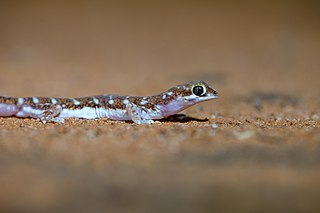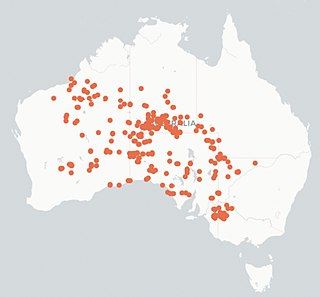
Lizard is the common name used for all squamate reptiles other than snakes, encompassing over 7,000 species, ranging across all continents except Antarctica, as well as most oceanic island chains. The grouping is paraphyletic as some lizards are more closely related to snakes than they are to other lizards. Lizards range in size from chameleons and geckos a few centimeters long to the 3-meter-long Komodo dragon.

Gekkonidae is the largest family of geckos, containing over 950 described species in 62 genera. The Gekkonidae contain many of the most widespread gecko species, including house geckos (Hemidactylus), the tokay gecko (Gekko), day geckos (Phelsuma), the mourning gecko (Lepidodactylus), and dtellas (Gehyra). Gekkonid geckos occur globally and are particularly diverse in tropical areas. Many species of these geckos exhibit an adhering ability to surfaces through Van der Waals forces utilizing intermolecular forces between molecules of their setae and molecules of the surface they are on.
The western beaked gecko is a species of gecko found throughout the interior of Australia.

The thorny devil, also known commonly as the mountain devil, thorny lizard, thorny dragon, and moloch, is a species of lizard in the family Agamidae. The species is endemic to Australia. It is the sole species in the genus Moloch. It grows up to 21 cm (8.3 in) in total length, with females generally larger than males.

The sandhill dunnart is a species of carnivorous Australian marsupial of the family Dasyuridae. It is known from four scattered semi-arid areas of Australia: near Lake Amadeus in Northern Territory, the central and eastern Eyre Peninsula in South Australia, the southwestern and western edges of the Great Victoria Desert in Western Australia, and at Yellabinna in South Australia.

The spiny-cheeked honeyeater is the only species in the genus Acanthagenys. It is large for a honeyeater, ranging from 22 to 27 centimeters tall and weighing around 52 grams. The birds are sociable, aggressive, and often observed foraging in large flocks.

The Diplodactylidae are a family in the suborder Gekkota (geckos), with over 150 species in 25 genera. These geckos occur in Australia, New Zealand, and New Caledonia. Diplodactylids are the most ecologically diverse and widespread family of geckos in both Australia and New Caledonia, and are the only family of geckos found in New Zealand. Three diplodactylid genera have recently been split into multiple new genera.

Ochetellus is a genus of ants first described by Steve Shattuck in 1992. He placed it in the subfamily Dolichoderinae of the family Formicidae. The ants in this genus are small and black in colour; workers measure 1.75 to 3 millimetres in length, the males at around 1.6 millimetres (0.06 in) are smaller, and the queens are the largest, reaching 4 millimetres (0.16 in). There are seven described species and three described subspecies that mostly live in Australia in a wide variety of habitats, but some species are found in Asia. One species, Ochetellus glaber, has been introduced into New Zealand and the United States.

Diplodactylus conspicillatus, also known commonly as the variable fat-tailed gecko or the burrow-plug gecko, is a species of lizard in the family Diplodactylidae. The species is endemic to Australia, where it is found in central and arid inland areas. Widespread across the continent, the variable fat-tailed gecko is most commonly found in sandy desert habitats dominated by spinifex grasses. It has also been bred in captivity by zoos and as pets.

The Mokopirirakau genus comprises alpine geckos found only in New Zealand. The name is Māori, and comes from “Moko”, referring to lizards, and “pirirakau”, which refers to forests. This is a newly recognized genus as it was previously included in the Hoplodactylus genus. Many of the species within this genus are still at candidatus status because of this, but also because of the difficulty that comes with researching these species and this genus in particular. Much of the current research about geckos in New Zealand is built off assumptions, indicating that better surveying methods are needed to come to any real conclusions about their behaviour and ecology.

The eastern beaked gecko is a gecko endemic to arid zones of New South Wales and Queensland in Australia.

The border beaked gecko is a gecko endemic to Australia in the family Gekkonidae. It is known for its distinctive beak-like snout and ability to camouflage itself in its surroundings.

The Eyre Basin beaked gecko is a gecko endemic to Australia in the family Diplodactylidae. It is found throughout parts of South Australia, Queensland and the Northern Territory and New South Wales.

Strophurus williamsi, also known commonly as the eastern spiny-tailed gecko, the soft-spined gecko, and Williams' spiny-tailed gecko, is a species of lizard in the family Diplodactylidae. The species is endemic to semi-arid regions of eastern Australia including Queensland, New South Wales, Victoria and South Australia. It has become a popular species as a pet for its distinctive tail features. S. williamsi has been grouped within a clade of seven other species that are believed to have diverged from their ancestors around 20 million years ago. S. williamsi can be distinguished from closer relatives by arboreality and diurnal (day-active) activity.

Gehyra versicolor, commonly known as the eastern tree dtella. is a native Australian gecko occurring in temperate forests of eastern Australia.

Ctenophorus tjantjalka, also known as the ochre dragon, is a species of agamid lizard occurring on low, weathered, crumbling outcrops and stony hills in arid South Australia, from the Painted Hills north-west to the base of the Everard Ranges.

Ctenotus pantherinus, commonly known as the leopard ctenotus, is a species of skink endemic to central and western Australia. Its conservation status is currently classified as Least Concern.
Ctenotus atlas, the southern Mallee ctenotus, is a medium sized lizard in the family scincidae (skink) found in the central and southern interior regions of South Australia and Western Australia; the Mallee regions of NSW and Victoria, in Australia.

Ctenotus brooksi, also known commonly as Brooks' wedge-snouted ctenotus, the wedgesnout ctenotus, and the sandhill ctenotus, is a species of skink, a lizard in the family Scincidae. The species is endemic to Australia and found in semi-arid regions.

Ctenotus leonhardii, known by the common names Leonhardi's ctenotus, Leonhardi's skink or common desert ctenotus, is a species of skink found in a range of arid and semi-arid regions throughout mainland Australia. The species was named after German anthropologist Moritz von Leonhardi in 1919 and belongs to the genus Ctenotus, one of the largest genera of lizards in Australia.




















